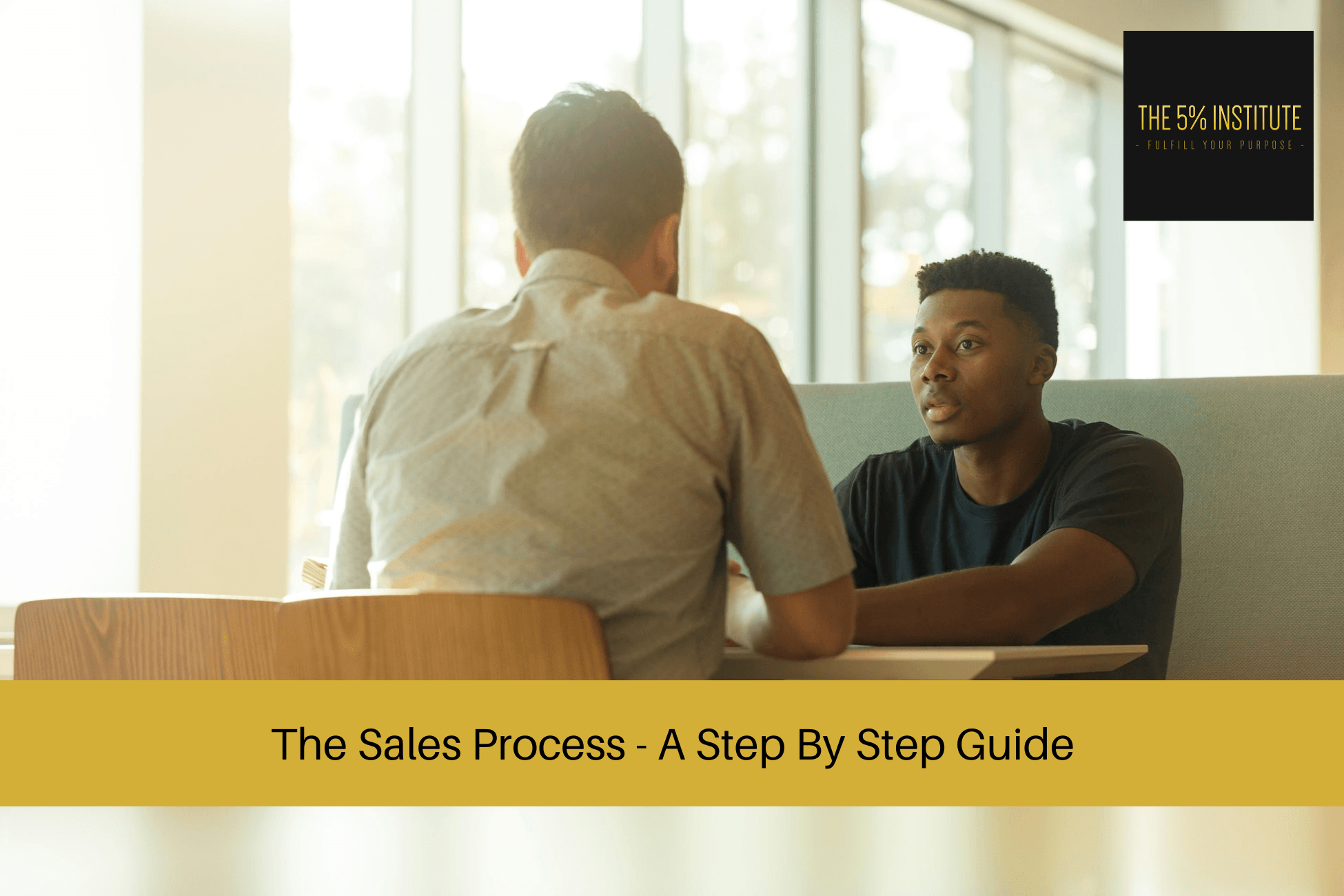
The Sales Process – A Step By Step Guide
Over the years, I’ve trained thousands of Sales Professionals and Business Owners, and I often find the same thing missing in their sales approach – they’re missing a sales process / selling process.
They usually ‘wing it’, and aren’t follow a step by step structure.
By sales process, I mean a systematic system to give you consistent results.
Many people tend to follow ‘instinct’, or just do what feels right at the time.
Although this may seem like the right way of doing things; what it does instead is gives you inconsistent results, because you’re being inconsistent with your sales process.
The Sales Process – Why Do You Need It Anyway?
Everything in life that creates consistent results and outcomes, is governed by a process.
Whether we are consciously mindful of it or not; all around us at all times, are systems, processes and formulas at work.
When it comes down to sales / selling process, I find that Sales Professionals or Business Owners generally lack it for the following reasons.
They’re either unaware of what a sales process looks like.
Sometimes they may be familiar with the term, but don’t know where to start.
Other times, they may be using a sales process but it is of an old school model, which in turn is giving their either poor results, or inconsistent ones.
A modern sales process will give you many benefits, that’ll we’ll look at now.
The benefits of using a sales process
Following a sales process, or sales formula as some call it, is the step-by-step system of taking a potential client on a journey from start to finish. It usually start with getting to know the clients, following a number of steps, and finalising by asking for the sale.
A good sales process should do the following:
- Is systematised in a way, that gives you some kind of clear outcome
- Something you can follow consistently; a road map you can keep using
- Creates certainty for both you and your potential client
- Allows you to control the process
By following a sales process, it allows you to feel confident and secure before walking into any potential client interview. It gives you consistency, because you don’t have to wonder what to ask, or waste time, money or resources.
A proven sales process
My experience is most probably just like yours; from being in the trenches of sales, growing my business day to day. What I learnt many years ago, is that when I wasn’t following a sales process, my results were inconsistent. Even though I may have felt OK; my results were mixed.
It’s only when I started reading, learning, and spending thousands on my own personal development that I learnt how to put various pieces of the sales process together, and come up with my own proven sales process.
Today, I call this sales process The 5% Sales Blueprint.
Sales Process Steps – The 5% Sales Blueprint
Below I’m going to share with you the steps of our sales process – The 5% Sales Blueprint.
Rapport
The first step in any sales process, is building rapport. Contrary to some of the older style lessons you may read in old sales books, rapport isn’t about acting all enthusiastic and over excited.
Instead, rapport done correctly is meeting people on their level with a confident and pleasant attitude, so that the potential client will feel the need to reciprocate this comfort level.
By doing this, it allows the opportunity for your potential client to open up and answer the questions you’ll be asking. It also encourages them to speak truthfully; which is an important key ingredient in the sales process.
Setting pre-frames
Do you ever wonder why some potential clients are inclined to always think about it, or need to ask their business partner/ wife/ husband before they can proceed?
This is because there are no up-front expectation or parameters set up between yourself and your potential client.
What pre-framing is, is setting up a frame of how the conversation will go, and letting them know in advance so that they get a sense of certainty; rather than not knowing how the conversation may go. The last thing they want is feeling like you might get all salesy or pushy on them later.
To learn more about how to use pre-frames and minimising the mentioned objections up front, check out our article here covering the topic.
By establishing pre-frames, you maintain control of the sales process in an ethical, non-pushy manner.
This ingredient has been absolute game changing for most of our students.
Sales Questions
At The 5% Institute, we call these Power Questions.
Have you ever wondered why some Sales Professionals or Business Owners get great traction in the market, and some just casually cruise by, not really making any dent at all?
People often mystify the reasoning, and think it comes down to their ‘closing prowess’, or technique.
This couldn’t be further from the truth.
Instead, it comes down to their relationship building, and more importantly; ability to ask the right questions.
That’s why we call them power questions.
Surface Selling & Iceberg Selling
In our sales process, we teach two concepts – surface selling, and iceberg selling.
Most Sales Professionals and Business Owners use surface selling methods. This is bad for your sales, because it means you stay on the surface with your potential client, rather than get down below and find out what’s really keeping them up at night.
The conversation generally feels very logical, back and forth, with no real emotion involved.
Most successful Business Owners and Sales Professionals (the top 5%) instead use iceberg-selling methodology in their sales / selling process.
They understand that they need to go a few layers deeper when asking questions, to find the truth as to what the potential client is really trying to find a solution for.
What they say, and what they really want on a deep and emotional level are two different things.
A surface level answer may be the potential client wants leads for the business, or a house to live in.
An iceberg level answer may mean they want leads because they need income, meaning security for their family.
The other may not just a house, but a house closer to work; which means less commute time, meaning less time in traffic and more time to go to the gym and stay in shape.
Power questions are like special keys that unlock what people really want and need.
The pain process in sales
“No pain – no gain”.
A common phrase, and I’d like to add to that; no pain, no sale!
In order to ask a potential client for their business, there needs to be a conversation based on emotion.
And by emotion in this instance, there needs to be pain – meaning displeasure with their current situation, and a motivation for change.
Pleasure and future pacing
As mentioned, without emotion it’ll be very difficult to spate yourself as a commodity, and make a sale. Pain in the first emotional driver behind your sale.
The second is pleasure, or where they want to get.
What will it positively mean if they solve their problem and pain? What does the future look like with their problem solved? Understanding this concept and getting them there will take you one-step towards the sale in the sales / selling process.
Talking about money
We call this segment money talk – meaning finding out what they will put aside to fix the problem, and what they currently have budget wise to fix it.
How often have you come to the end of the conversation, and found that they tell you it’s too expensive, or that they need to shop around on price?
This comes up for two reasons.
- You haven’t learnt enough about their budget constraints/ budget appetite before asking for the sale
- You haven’t built enough value in your questioning, to validate your actual price
Money talk is very important in the sales process, and a must have conversation.
Presenting
Here is where we truly stand out from other sales process.
At The 5% Institute, we teach that unless you truly know that they are a qualified potential client, that you clearly know their pain and pleasure, and what it is they exactly want and need and know their budget; only then can you present.
What separates our students from the rest, is that they learn only when you completely understand the outcome your potential client wants, can you have the right to present and show how you’ll make that happen.
Tailor your presentation to their wants and needs, versus going off a boring PowerPoint presentation like your competitors do.
This will show you actually care about diagnosing and solving their problems, rather than going the usual commodity route.
Handling objections
If you’re involved in sales, you need to have handling objections in your sales / selling process.
When handling objections, you want to understand two distinct features.
- Understand the rationale behind the objection
- Ask them questions, to help them overcome their own objection.
Objections usually come from two places – these are a lack of trust, and lack of desire.
To learn how to handle objections, check out the articles we’ve written on the topic here.
Closing
Once you have overcome the areas of concern (objections), you may ask for the sale.
Asking for the sale is a lot easier, when you have helped your potential client overcome their own objections, and tailored your presentation based on their pain points and pleasure.
Final thoughts on the sales process
The 5% Sales Blueprint is the perfect sales process for you and your business, if you’re selling medium to high priced items.
To learn more about our programs, click the link here to learn more.



